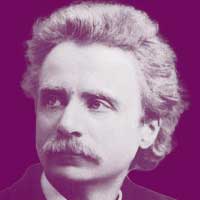Edvard Grieg Biography - A Very Quick Guide
Artist:
Edvard Grieg
Born:
1843, Bergen
Died:
1907, Bergen
Who Was Edvard Grieg?
Edvard Grieg (1843–1907) was a Norwegian composer and pianist whose music became a defining force in the creation of a distinct Norwegian national style. His works combine lyrical melodies, modal inflections, and folk-inspired rhythms, and he was a prominent contributer to the wider European interest in national schools of composition during the late 19th century.
What Is Grieg Most Famous For?
Grieg is best known for the Piano Concerto in A minor (1868) and the two Peer Gynt suites, which include widely much-loved pieces like “Morning Mood” and “In the Hall of the Mountain King.” He also wrote a substantial body of piano music that highlights his gift for concise, character-driven miniatures. He also wrote songs, chamber works and choral compositions.
What Influenced Grieg’s Music?
Grieg drew heavily on Norwegian folk music, particularly its modal harmonies, asymmetric rhythms, and dance-derived motifs. Encounters with folk fiddlers and the Hardanger fiddle tradition shaped his harmonic and melodic language. His training at the Leipzig Conservatory exposed him to German Romanticism - especially the works of Mendelssohn and Schumann - leading to a synthesis of folk-inspired ideas with established European formal models.
When Was Edvard Grieg Born?
Grieg was born on June 15, 1843, in Bergen, Norway. After early piano studies with his mother, he trained in Leipzig and later worked in Copenhagen before eventually returning to Norway.
How Did Edvard Grieg Die?
He died on September 4, 1907, in Bergen, at the age of 64, from complications related to long-term respiratory illness, including pleurisy and emphysema.
10 Facts About Edvard Grieg
Edvard Grieg (1843–1907) was a Norwegian composer and pianist whose music became a defining force in the creation of a distinct Norwegian national style. His works combine lyrical melodies, modal inflections, and folk-inspired rhythms, and he was a prominent contributer to the wider European interest in national schools of composition during the late 19th century.
What Is Grieg Most Famous For?
Grieg is best known for the Piano Concerto in A minor (1868) and the two Peer Gynt suites, which include widely much-loved pieces like “Morning Mood” and “In the Hall of the Mountain King.” He also wrote a substantial body of piano music that highlights his gift for concise, character-driven miniatures. He also wrote songs, chamber works and choral compositions.
What Influenced Grieg’s Music?
Grieg drew heavily on Norwegian folk music, particularly its modal harmonies, asymmetric rhythms, and dance-derived motifs. Encounters with folk fiddlers and the Hardanger fiddle tradition shaped his harmonic and melodic language. His training at the Leipzig Conservatory exposed him to German Romanticism - especially the works of Mendelssohn and Schumann - leading to a synthesis of folk-inspired ideas with established European formal models.
When Was Edvard Grieg Born?
Grieg was born on June 15, 1843, in Bergen, Norway. After early piano studies with his mother, he trained in Leipzig and later worked in Copenhagen before eventually returning to Norway.
How Did Edvard Grieg Die?
He died on September 4, 1907, in Bergen, at the age of 64, from complications related to long-term respiratory illness, including pleurisy and emphysema.
10 Facts About Edvard Grieg
- He is Norway’s most internationally recognized composer.
- His Piano Concerto was admired by Liszt, who read it at sight and played it for Grieg.
- Grieg incorporated Norwegian folk modes such as Lydian and Mixolydian into his harmonic language.
- He wrote 66 Lyric Pieces for piano across his career.
- His home, Troldhaugen, is now a museum and major cultural landmark.
- He collaborated closely with playwright Henrik Ibsen on the music for Peer Gynt.
- His Holberg Suite adapts 18th-century dance forms through a Romantic lens.
- He was an influential pianist and conductor, frequently touring Europe.
- His String Quartet in G minor features cyclical thematic unity.
- Grieg’s music helped establish a national identity during Norway’s push for independence in the late 19th century.
Top Pieces on 8notes by Edvard Grieg
